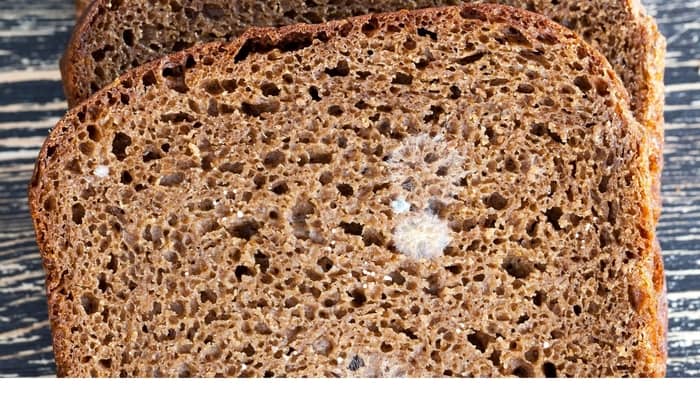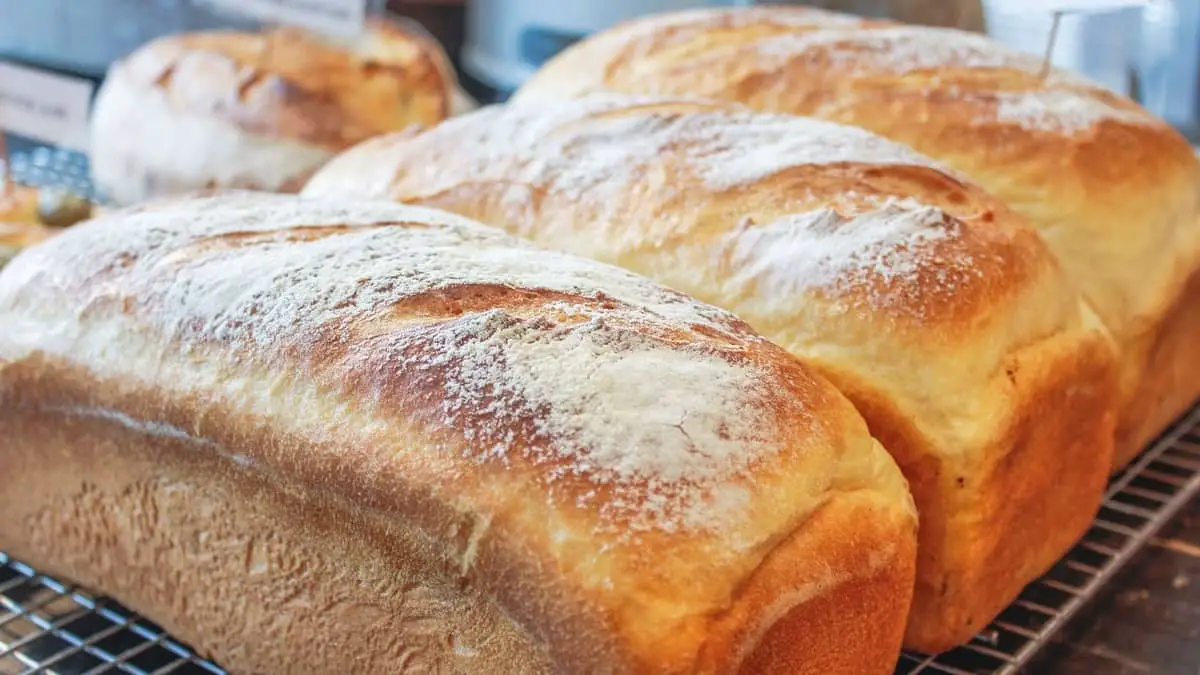Last Updated on December 16, 2022
When reaching for a loaf of bread to make a sandwich, you might notice some odd white patches. So, what is white stuff on bread? If you notice any white stuff on the bread, be sure to check it out because depending on closer inspection it could be mold or flour.
While spots of flour on bread are safe to eat, mold is not. Eating mold can make you sick and can even cause health problems. It is important to be able to properly identify the white stuff on bread to ensure that it is safe to eat.
What Is The White Stuff On Bread?
The white stuff you see on bread could be two different things: flour or mold. While flour on bread is safe to eat, mold, on the other hand, is not. It is important to be able to safely distinguish the two so you know whether you can eat your bread or if you should throw it out.
Mold
Though many people associate mold with being green, it can also be white. Mold may start out as small white spots that grow into larger spots that are fuzzy with hints of green and blue.
You will also notice that mold will have an unpleasant smell. The white is often a dirty white that may include green, blue, or even gray splotches. Though some mold may have a smooth texture, it is common for it to have a fuzzy appearance.
Within a couple of days, the mold will continue to grow and spread on your bread. It will likely begin to change colors over time as well.
Flour
Oftentimes, artisan bread will have flour dusted on it. The flour on your bread is completely safe to eat and is nothing to worry about.
Flour has a smooth texture and is a brighter white than mold. It will not have any other colors throughout it, it will only be white. Flour on bread will simply just smell like bread, it doesn’t have a distinct smell like mold that will set it apart from the smell of bread.
Flour may be on both the top and bottom of the bread. Though not all bread will have flour sprinkled on it, many loaves of bread do. It is particularly common on bread that comes from bakeries.
Why Does Bread Have Flour On It?
There are a few reasons your bread may have floured sprinkled on it. Though most name-brand varieties of bread will not have flour sprinkled on them, a lot of freshly baked bakery bread will.
Prevents sticking
It is not uncommon to use flour when making and baking bread to prevent sticking. Bakers will also often coat their hands with flour while working with the dough to prevent sticking. The flour that is sprinkled on the bread during this process sometimes will remain on after packaging.
Bread Knife, imarku German High Carbon Stainless Steel Professional Grade Bread Slicing Knife
Gives a rustic appearance
Artisan bread often has flour sprinkled on it to give it a rustic appearance. Though sprinkling flour on bread doesn’t necessarily do anything for flavor or texture, it gives the bread an aesthetically pleasing look.
Can be used to distinguish different loaves
In some bakeries, bakers may sprinkle flour on bread to create different shapes and patterns. This can be done to help distinguish different types of loaves from each other.
What Causes Mold on Bread?
There are a few different reasons why mold may grow on your bread. The most common reason that causes it to happen is that bread was exposed to a warm, moist environment. Warm temperatures and moisture with limited airflow will often result in moldy conditions.
Moisture
Bread naturally contains moisture and when not properly stored, the moisture in the bread can cause mold. In addition, exposure to excess moisture, especially from humidity, mold growth can happen sooner and spread faster.
Be sure to store your bread in a cool, dry environment to prevent the growth of mold. Store your bread in a paper bag, a bread box, or an airtight container.

Temperature
Temperature is another big factor in the cause of mold growth. Mold strives in temperatures between 77 to 86 degrees Fahrenheit.
For best results, store your bread in temperatures 70 degrees and below. If the temperatures are too warm and humid, you can store your bread in the fridge or freezer.
To store your bread in the freezer, wrap it in a layer of plastic wrap and a layer of aluminum foil. For store-bought bread, you can put it in the freezer in a bag that it came in.
To defrost, place your bread on the countertop for around one to two hours or thaw it overnight in the fridge. In addition, you can also defrost it by heating slices for around 15-30 seconds in the fridge.
Does White Bread Mold Faster Than Wheat?
In short, the answer is: yes. White bread typically goes stale and produces mold much faster than whole wheat bread does. If bread is stored correctly, it will stay fresher for longer; whichever type of bread it is. It’s worth noting that homemade bread usually produces mold much faster than its commercially produced counterpart. This is because preservatives are often added to store-bought bread. Another point worth mentioning is that the density of the bread also affects how quickly mold builds.
The lighter the bread, the quicker mold usually occurs. For long-lasting bread, keep it out of sunlight. A cool, dark place works best.
What is the Scientific Name For Bread Mold?
White bread mold has a specific scientific name. This name is Rhizopus stonlonifer. This mold is one of the most common types of fungi in the world, as bread is one of the most popular food products globally. This particular type of mold is part of the Zygomycota family.
How to Get Mold Off Bread?
When it comes to removing mold from bread, you can use a sharp knife to remove any of the bread that has been contaminated with mold. However, while it may be tempting to cut or scrape off any mold and keep the rest of the loaf, this is not advised. This is because bread is particularly porous and will spread through the rest of the loaf quickly.
Along with this, some of the poisons caused by mold can be invisible, such as mycotoxin. For this reason, it’s simply not worth the risk of removing mold from bread and consuming the rest.
Can Mold Grow on Toasted Bread?
While it’ll take considerably longer for mold to grow on toasted bread, it can and will happen if left long enough. Mold grows on bread because of the moisture content. However, when toasted, the bread is now dry.
But the moisture from the environment around your bread will eventually make its way into the bread and contaminate it; it will just be a slower process. It’s also worth noting that toasting moldy bread will not remove any mold and it is still completely unsafe for you to eat.
What Does Wheat Bread Mold Look Like?
Wheat bread mold can appear in many different ways and forms. Typically bread should look “clean” and bright white. However, once mold begins to appear, the shade will be more off-white and will often have spots of color it should not be, such as green, blue, black, yellow, green, or grey.
Green is usually the most common color of the mold, but it will all depend on the type of fungus that has appeared. Some popular types of mold that may appear are Rhizopus nigricans, Penicillium, and aspergillus.
How Quickly Does Bread Get Moldy?
Several factors will affect how quickly your bread becomes moldy. However, typically, the bread will start to grow mold within 3-7 days at room temperature. The more humid the environment the bread is left in, the shorter shelf life it will have and the quicker mold will begin to grow.
Storing it in a cool, dry place will help to prevent this. Also, whether your bread is store-bought or homemade will make a difference. Homemade bread tends to grow mold much quicker than store-bought bread because it doesn’t have the added preservatives.
The estimated shelf life of homemade bread is 3-5 days, whereas the estimated shelf life of store-bought bread is 5-7 days. This, of course, all depends on whether or not it is stored correctly.
Making Sure Your Bread Is Safe To Eat
If you see white on your bread, it will either be from mold or flour. It is safe to eat flour on bread, but it is not safe to eat mold.
Do you have any questions regarding what the white stuff on the bread is? If so, please ask any bread questions in the comments.
FAQs
What is the White Stuff on Bread?
The white stuff on bread is either mold or flour. If it is is mold, it will likely have a slightly fuzzy texture, off smell and have may have splotches of green or blue. For flour, it will be brighter white and have a neutral smell.
Why Is There White Stuff on My Bread?
The white stuff on your bread comes from either mold or flour. Mold tends to grow in warm, moist environments and flour is put on bread to prevent sticking and give it a rustic look.
Is the White Stuff on Bread Mold or Flour?
If the white stuff on your bread appears in splotches, has a fuzzy texture and has spots of gray, blue or green, then it is mold. If the white stuff is sprinkled on, smells like bread and is bright white, then it is flour.
Can I Eat Bread with White Spots?
If you are able to identify the white spots as flour, then the bread is safe to eat. However, if the white spots are mold, do not eat the bread.

Ever since she was a young girl, Anna has been a lover of desserts. As an adult, she enjoys
baking a variety of desserts from cakes, cookies, brownies, bread, and more from scratch. She
enjoys sharing her passion for baking with others who also have a sweet tooth. From properly
measuring ingredients to making sure they are the correct temperature, Anna knows the
importance small details can make in baking. She wants to share her experience with others in
hopes they can make the most delicious baked goods. When she’s not busy blogging, Anna
enjoys trying new recipes in the kitchen.


